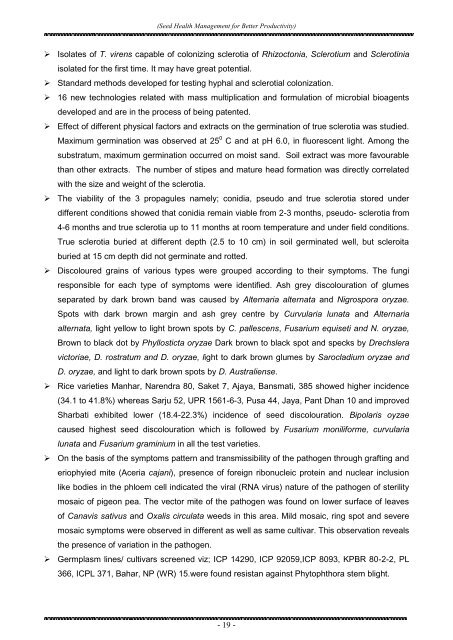Seed Health Management for Better Productivity - Govind Ballabh ...
Seed Health Management for Better Productivity - Govind Ballabh ...
Seed Health Management for Better Productivity - Govind Ballabh ...
You also want an ePaper? Increase the reach of your titles
YUMPU automatically turns print PDFs into web optimized ePapers that Google loves.
(<strong>Seed</strong> <strong>Health</strong> <strong>Management</strong> <strong>for</strong> <strong>Better</strong> <strong>Productivity</strong>)‣ Isolates of T. virens capable of colonizing sclerotia of Rhizoctonia, Sclerotium and Sclerotiniaisolated <strong>for</strong> the first time. It may have great potential.‣ Standard methods developed <strong>for</strong> testing hyphal and sclerotial colonization.‣ 16 new technologies related with mass multiplication and <strong>for</strong>mulation of microbial bioagentsdeveloped and are in the process of being patented.‣ Effect of different physical factors and extracts on the germination of true sclerotia was studied.Maximum germination was observed at 25 0 C and at pH 6.0, in fluorescent light. Among thesubstratum, maximum germination occurred on moist sand. Soil extract was more favourablethan other extracts. The number of stipes and mature head <strong>for</strong>mation was directly correlatedwith the size and weight of the sclerotia.‣ The viability of the 3 propagules namely; conidia, pseudo and true sclerotia stored underdifferent conditions showed that conidia remain viable from 2-3 months, pseudo- sclerotia from4-6 months and true sclerotia up to 11 months at room temperature and under field conditions.True sclerotia buried at different depth (2.5 to 10 cm) in soil germinated well, but scleroitaburied at 15 cm depth did not germinate and rotted.‣ Discoloured grains of various types were grouped according to their symptoms. The fungiresponsible <strong>for</strong> each type of symptoms were identified. Ash grey discolouration of glumesseparated by dark brown band was caused by Alternaria alternata and Nigrospora oryzae.Spots with dark brown margin and ash grey centre by Curvularia lunata and Alternariaalternata, light yellow to light brown spots by C. pallescens, Fusarium equiseti and N. oryzae,Brown to black dot by Phyllosticta oryzae Dark brown to black spot and specks by Drechsleravictoriae, D. rostratum and D. oryzae, light to dark brown glumes by Sarocladium oryzae andD. oryzae, and light to dark brown spots by D. Australiense.‣ Rice varieties Manhar, Narendra 80, Saket 7, Ajaya, Bansmati, 385 showed higher incidence(34.1 to 41.8%) whereas Sarju 52, UPR 1561-6-3, Pusa 44, Jaya, Pant Dhan 10 and improvedSharbati exhibited lower (18.4-22.3%) incidence of seed discolouration. Bipolaris oyzaecaused highest seed discolouration which is followed by Fusarium monili<strong>for</strong>me, curvularialunata and Fusarium graminium in all the test varieties.‣ On the basis of the symptoms pattern and transmissibility of the pathogen through grafting anderiophyied mite (Aceria cajani), presence of <strong>for</strong>eign ribonucleic protein and nuclear inclusionlike bodies in the phloem cell indicated the viral (RNA virus) nature of the pathogen of sterilitymosaic of pigeon pea. The vector mite of the pathogen was found on lower surface of leavesof Canavis sativus and Oxalis circulata weeds in this area. Mild mosaic, ring spot and severemosaic symptoms were observed in different as well as same cultivar. This observation revealsthe presence of variation in the pathogen.‣ Germplasm lines/ cultivars screened viz; ICP 14290, ICP 92059,ICP 8093, KPBR 80-2-2, PL366, ICPL 371, Bahar, NP (WR) 15.were found resistan against Phytophthora stem blight.- 19 -
















